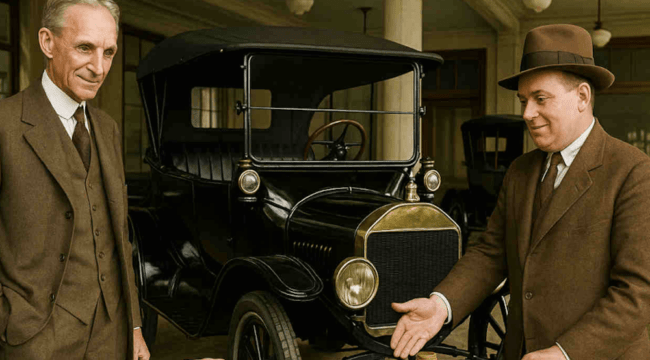Sticker Shock at the Auto Museum: Let’s Price Things in Gold
“The bank that has only enough cash for its daily requirements is unsafe,” noted Henry Ford in 1906. “And the car with only enough power for ordinary use falls down in an emergency,” he added.

Henry Ford, circa 1915. Courtesy Ford Motor Company.
As a budding industrial tycoon in America’s gold-standard days, pre-Federal Reserve, Mr. Ford knew a thing or two about cash, banks and unsafe banking. And we’ll get into that, plus gold as this note unfolds. But first, let’s discuss cars.
A Car that People Could Afford to Buy… With Gold
Begin with Ford’s view on underpowered cars which he compared, after a fashion, to undercapitalized banks. Arguably, Ford had a valid point; you want your car to pull through when you need it, just like with your bank. Then again, Ford was writing in 1906 and what did anybody, anywhere know at the time about the “ordinary use” of those new, fast-evolving, internal combustion contraptions?
In other words, automobiles in Ford’s early days were unusual, and expensive oddities. Both the customer base and distribution of cars was limited, if for no other reason than lack of roads and access to motor fuel. And then there was the cost of a set of wheels, which we’ll address in a moment.
When Ford compared underpowered car engines to weak banks, it’s likely that the Michigan businessman was talking his book. Because in the early days of Ford’s eponymous car company, he experimented with what people would or could buy. He tested the marketplace and, among his early products, between 1906-08 Ford produced a vehicle powered by a then-innovative 6-cylinder engine.

Ford 1907 Model K Roadster. Courtesy Fountainhead Antique Auto Museum, Fairbanks, Alaska. BWK photo.
This early Ford automobile was called the Model K, described at the time as a “6-40 Roadster,” shown above in mint-like condition at the Fountainhead Antique Auto Museum, in Fairbanks, Alaska.
As an aside… I recently made a sojourn to the 49th State. I spent several dawn-to-dusk days (which are quite long in the high summer latitudes), kicking rocks out in the field and assessing a set of gold exploration and development projects. Then I carved out time to visit the totally first-class Fountainhead Museum. And if you ever have the chance to visit this site, go there and check the place out, with its astonishing automotive exhibits! Now, back to the story…
As I mentioned above, Ford experimented during his early days in the car biz. His goal was to determine what people would buy or not buy. He priced his Model K at $2,800 out of the factory gate, which was quite an ask in an era when the price of gold was $20 per ounce.
To compare the economics, let’s put Ford’s Model K into modern terms, with gold now priced over $3,450 per ounce, or 165 times its dollar price in 1906. So, are you sitting down? Because at first, the math is shocking; but numbers are numbers, and buying a Model K back then was equivalent to paying $462,000 today for a car. In other words, buying Ford’s Model K was the same payout as buying a house in many parts of the modern U.S.
Over its two-year production run, Ford rolled out a mere 900 Model Ks before discontinuing the line. The buyers weren’t there, and the numbers didn’t work, which led Mr. Ford to rethink his price points and develop the less costly, but now iconic, Model T, aka Ford’s “car for the multitudes.”

Ford 1909 Model T. Courtesy Fountainhead Antique Auto Museum, Fairbanks, Alaska. BWK photo.
The Fairbanks Fountainhead Museum holds an early, 1909 Model T in its collection, pictured above. In fact, it’s among the first cars ever to make it up to Alaska. Its voyage began on a cargo ship north from Seattle, and then a barge up the Yukon River.
This particular specimen is red, although Ford’s standard Model T product was black because, according to Mr. Ford himself, black paint dried faster. That, and one single color lowered Ford’s production costs at the company’s Michigan assembly works, as well as with knock-down kits that Ford sold to mini-assembly plants across the U.S., and later the world.
Of course, customers were always welcome to repaint their cars after they bought them. And Henry Ford did not believe in financing sales, so it was cash on the table. (Ford Credit Company came many decades later.)
In 1908, Ford released its Model T car, powered by a 4-cylinder engine built around a single, cast block of steel. The power train was uncomplicated, packed inside the enclosed body of the vehicle, and the car’s inner workings were generally understandable to both owners and mechanics.
Ford placed the steering wheel on the left side of the vehicle, as opposed to the middle of the seat or on the right. Although, little did Mr. Ford know that he was establishing a near-global specification that lasts even now, over 115 years later, except in places where they do it backwards like the U.K, Australia, Japan, etc.
In many ways, Ford’s Model T was intuitive to drive, plus easy and inexpensive to repair. All this, and the car offered a small measure of upscale comfort, if for no other reason than its suspension was based on two semi-elliptic steel springs. Well, at least it beat the heck out of riding in a hay wagon.
Ford’s first Model T cars were priced at $825 in 1908, or the modern equivalent of $136,125 in terms of the current price of gold. Pricey, yes, then as now; although in short order, and based on economies of scale, Ford’s internal costs declined. Thus by 1916, Ford sold Model T cars for as little as $360, equivalent to $59,400 today.
And whatever one might think of the price and associated sticker shock then or now, Ford’s product was wildly successful. Indeed, by 1918 about half of all cars on the road in the U.S. were Model Ts.
Money Then, Money Now
I could write all day about the fabulous collection of antique cars on display at the Fountainhead Museum in Fairbanks. They range from Ford’s above-noted Model T to Pierce Arrows, early Lincolns and Cadillacs, Packards, Duesenbergs, and many more whose names you may have never heard or seen. And I mean a lot more cars and makers, as in pure eye candy! The collection is focused on early model cars, made in America up to about World War II.
The cars themselves, of course, exhibit all manner of design and engineering innovations over the early decades of the 20th century. Absolutely, cars improved by leaps and bounds in terms of quality, design, materials and manufacture. These developments include everything from steadily evolving tires and wheels to drivetrains, headlamps, interior seating, hood ornament artistry and much else.
One thing that astonished me at the museum was the original sticker price of most of the cars. I’ll offer just a few examples below, and yes, they were very expensive in their day. But what’s even more eye-popping (certainly to me) is when you translate prices from back then, with $20 gold, to now, 92 years after America’s gold currency went away in 1933 under President Roosevelt.
For example, here’s a 1927 Lincoln Imperial Victoria, originally priced over $15,000 back in its day and fresh out of the assembly plant. Of course, Lincoln (by then owned by Ford Motor Company) promised the buyer “Faultless precision with incomparable smoothness and high speed.” Today, the equivalent price in gold is $2,475,000:

Lincoln 1927 Imperial Victoria. Courtesy Fountainhead Antique Auto Museum, Fairbanks, Alaska. BWK photo.
And here’s a 1930 Packard; “Ask the man who owns one” was the marketing hook. It cost $4,585 from the factory back then, just as the Great Depression kicked off, equivalent to $756,525 today:

Packard 1930. Courtesy Fountainhead Antique Auto Museum, Fairbanks, Alaska. BWK photo.
Or how about a 1932 Chrysler Custom Intrepid for $3,595 at the time, equivalent to $593,175 today. “Different and finer results from different, finer engineering,” went the sales pitch:

Chrysler 1932 Custom Intrepid. Courtesy Fountainhead Antique Auto Museum, Fairbanks, Alaska. BWK photo.
I could go on, but by now you get the idea; namely, that cars were quite expensive back then and not the mass-market, nearly consumer good that we have today upon roads across the world.
Back in the 1910s, buying even Ford’s (relatively) low-cost Model T required the equivalent of a year’s wage for many working people. At the higher-end, those more luxurious brands and models were destined only for the wealthiest of the era, from business titans to movie stars, and even organized crime figures like Al Capone.
Reviewing those old price lists today, and translating into gold equivalent, offers a truly scandalous indictment of how much purchasing power has been lost by dollar-holders over the past century and more.
Preserve Your Purchasing Power
Now we arrive at the takeaway of this note, which is to preserve your purchasing power in every way possible over time. Because as we just saw with automobile sticker prices over the past century, inflation is a thief that never stops robbing you, burgling you, pickpocketing your ability to hang onto what you’ve earned.
Let’s go back to what Henry Ford said, which I quoted at the beginning: “The bank that has only enough cash for its daily requirements is unsafe.”
Well, what if it’s worse than just with poorly capitalized, marginal banks? What if it’s the U.S. government that has only enough cash to pay out its daily requirements? Indeed, currently our federal government’s fiscal situation is pretty much there, with the bulk of tax receipts instantly going out as interest on the debt, plus entitlement spending on Social Security and Medicare. And more than a few state governments routinely fail to balance their books as well.
So, how do you think that the government authorities will keep up with their power and control? Yes, it’ll come out of your hide, whether in taxes or inflation; likely both. And this is a big problem, but also out of your hands. Sure, you can vote. Hey, vote as hard as you possibly can! But really… are the political class going to fix what’s broken? To quote former President Joe Biden on this matter, “Hey, c’mon, man.”
The best approach is to invest around and ahead of the problems coming down the road at us all, and a big element of that is to preserve wealth via hard assets, especially physical gold and silver, plus mining investments in companies with ore deposits in the ground.
This last angle is my stomping grounds here at Paradigm Press Group; I cover energy, mines, minerals, materials and related developments. And in weeks to come, I’ll discuss just this in articles in both Strategic Intelligence and Lifetime Income Report.
Oh, and I’ll tell you a few things about what I learned and saw up in Alaska, like the gold development projects. All that, besides spending quality time perusing the astonishing collection of antique cars at the Fountainhead Antique Auto Museum.
That’s all for now. Thank you for subscribing and reading.



Comments: